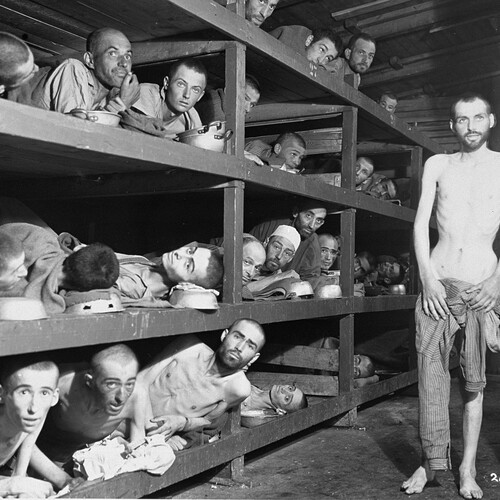Former prisoners of the "little camp" in Buchenwald stare out from the wooden bunks in which they slept three to a "bed."
Title
Former prisoners of the "little camp" in Buchenwald stare out from the wooden bunks in which they slept three to a "bed."
Creator
United States Holocaust Memorial Museum, courtesy of National Archives and Records Administration, College Park
Description
Elie Wiesel is pictured in the second row of bunks, seventh from the left, next to the vertical beam.
The man in the bottom left hand corner has been identified as Michael Nikolas Gruner, originally from Hungary, Gershon Blonder Kleinman or Yosef Reich. Isaac Reich is in the bottom row, second from the right and Max Hamburger is on the bottom row, fourth from the left. Perry Shulman from Klimitov, Poland is on the top bunk, second from the left (looking up). The man in the second row, third from left has been identified as Dawid Najman. The man in the second row, fourth from the left has been identified as Abraham Hipler; Berek Rosencajg from Lodz or Zoltan Gergely from Cluj. The man on the third bunk from the bottom, third from the left, has been identified alternatively as Ignacz (Isaac) Berkovicz, Abraham Baruch and Joseph Icovic )from Tecovo) . Juraj (now Naftali) Furst is pictured in the third bunk, fifth from the left. The man standing on the right has been identified as Chaim David Halberstam, and also as Simon Toncman. In the top left bunk, far right is Oscar Kleinshpitz (later Haberkorn). The man pictured in the middle bunk, fifth from the left (wearing a white cap) has been identified as Simon Brommet,. Simon was born in Amsterdam and was captured in Belgium. He survived a labor camp in Auschwitz, was marched to Buchenwald in the winter of 1945, and was liberated by American troops on April 11, 1945.
Original caption reads: "Slave laborers pedred from their tomb-like, wooden bunks at the concentration camp at Buchenwald, near Weimar, Germany, when U.S. troops liberated the area. Approximately 21,000 inmates - Russian, Polish, French, Italian, and Czechoslovakian - were freed. They were described as "the living dead". The camp doctors agreed that a t least 6,000 inmates had died as the result of German brutality during March, 1945. In the Winter of 1939, the prisoners died at the rate of 900 daily. In 10 years, more than 70,000 persons were starved and butchered in this atrocity center."
The man in the bottom left hand corner has been identified as Michael Nikolas Gruner, originally from Hungary, Gershon Blonder Kleinman or Yosef Reich. Isaac Reich is in the bottom row, second from the right and Max Hamburger is on the bottom row, fourth from the left. Perry Shulman from Klimitov, Poland is on the top bunk, second from the left (looking up). The man in the second row, third from left has been identified as Dawid Najman. The man in the second row, fourth from the left has been identified as Abraham Hipler; Berek Rosencajg from Lodz or Zoltan Gergely from Cluj. The man on the third bunk from the bottom, third from the left, has been identified alternatively as Ignacz (Isaac) Berkovicz, Abraham Baruch and Joseph Icovic )from Tecovo) . Juraj (now Naftali) Furst is pictured in the third bunk, fifth from the left. The man standing on the right has been identified as Chaim David Halberstam, and also as Simon Toncman. In the top left bunk, far right is Oscar Kleinshpitz (later Haberkorn). The man pictured in the middle bunk, fifth from the left (wearing a white cap) has been identified as Simon Brommet,. Simon was born in Amsterdam and was captured in Belgium. He survived a labor camp in Auschwitz, was marched to Buchenwald in the winter of 1945, and was liberated by American troops on April 11, 1945.
Original caption reads: "Slave laborers pedred from their tomb-like, wooden bunks at the concentration camp at Buchenwald, near Weimar, Germany, when U.S. troops liberated the area. Approximately 21,000 inmates - Russian, Polish, French, Italian, and Czechoslovakian - were freed. They were described as "the living dead". The camp doctors agreed that a t least 6,000 inmates had died as the result of German brutality during March, 1945. In the Winter of 1939, the prisoners died at the rate of 900 daily. In 10 years, more than 70,000 persons were starved and butchered in this atrocity center."
Date
1945 April 16
Source
https://collections.ushmm.org/search/catalog/pa6164
Collection
Citation
United States Holocaust Memorial Museum, courtesy of National Archives and Records Administration, College Park, “Former prisoners of the "little camp" in Buchenwald stare out from the wooden bunks in which they slept three to a "bed.",” Santa Clara University Digital Exhibits, accessed December 30, 2025, https://dh.scu.edu/exhibits/items/show/3965.
Embed
Copy the code below into your web page
Item Relations
This item has no relations.
